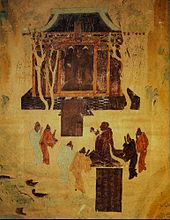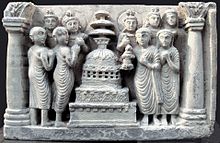Indo-Greek religions
In addition to the worship of the Classical pantheon of the Greek deities found on their coins (e.g., Zeus, Herakles, Athena, Apollo), the Indo-Greeks were involved with local faiths, particularly with Buddhism, but also with Hinduism and Zoroastrianism.
[3] Plutarch also presents Menander as an example of benevolent rule, and explains that upon his death, the honour of sharing his remains was claimed by the various cities under his rule, and they were enshrined in "monuments" (μνημεία, probably stupas), in a parallel with the historic Buddha: "But when one Menander, who had reigned graciously over the Bactrians, died afterwards in the camp, the cities indeed by common consent celebrated his funerals; but coming to a contest about his relics, they were difficultly at last brought to this agreement, that his ashes being distributed, everyone should carry away an equal share, and they should all erect monuments to him.
The inscriptions were found on a vase inside a stupa, dated to the reign of Menander or one of his successors in the 1st century BCE (Tarn, p391): "The meridarch Theodorus has enshrined relics of Lord Shakyamuni, for the welfare of the mass of the people"Although the spread of Buddhism to Central Asia and Northern Asia is usually associated with the Kushans, a century or two later, there is a possibility that it may have been introduced in those areas from Gandhara "even earlier, during the time of Demetrius and Menander".
Bhallika and Tapassu were both travellers, and if nothing else, the story of their conversion and their home region's Sanskrit nomenclature illustrates the possibility of early transmission via the local trade routes.
From around 180 BCE, Agathocles and Pantaleon, probable successors to Demetrius I in the Paropamisadae, and the earliest Greek kings to issue Indian-standard square bilingual coins (in Brahmi), depicted the Buddhist lion together with the Hindu goddess Lakshmi.
Also, after the reign of Menander I, several Indo-Greek rulers, such as Agathokleia, Amyntas, Nicias, Peukolaos, Hermaeus, Hippostratos, Menander II and Philoxenus depicted themselves or their Greek deities forming with the right hand a benediction gesture[12] identical to the Buddhist vitarka mudra (thumb and index joined together, with other fingers extended), which in Buddhism signifies the transmission of the Buddha's teaching.
Altogether, the conversion of Menander I to Buddhism suggested by the Milinda Panha seems to have triggered the use of Buddhist symbolism in one form or another on the coinage of close to half of the kings who succeeded him.
On the contrary, none of the kings whose rule was limited to Punjab did display Buddhist signs, with the exception of the powerful Hippostratos, who probably took under his protection many Gandharan Greeks fleeing from the Indo-Scythians.
[16] Also Chinese murals are known which describe Emperor Wu of Han worshipping Buddha statues brought from Central Asia in 120 BCE.
Stylistically, Indo-Greek coins generally display a very high level of Hellenistic artistic realism, which declined drastically around 50 BCE with the invasions of the Indo-Scythians, Yuezhi and Indo-Parthians.
Bhakti is a principle which evolved in the Bhagavata religious movement, and is said to have permeated Buddhism from about 100 BCE, and to have been a contributing factor to the representation of the Buddha in human form.
Since it already displays quite a sophisticated iconography (Brahma and Śakra as attendants, Bodhisattvas) in an advanced style, it would suggest much earlier representations of the Buddha were already current by that time, going back to the rule of the Indo-Greeks (Alfred A. Foucher and others): "It seems highly probable to me that the unknown artist who created the initial model [for the Buddha] was a Yavana, both artist and philosopher, who belonged both to Greece and India.
According to this perspective, the actual depiction of the Buddha would be a later phenomenon, usually dated to the 1st century CE, emerging from the sponsorship of the Indo-Scythians, Indo-Parthians and Kushans and executed by Greek, and, later, Indian and possibly Roman artists.
Another possibility is that the Indo-Greeks may not have considered the Buddha strictly as a God, but rather as an essentially human sage or philosopher, in line with the traditional Nikaya Buddhist doctrine.
The coinage depict various Indian iconography: Krishna-Vasudeva, with his large wheel with six spokes (chakra) and conch (shanka), and his brother Sankarshan-Balarama, with his plough (hala) and pestle (masala), both early avatars of Vishnu.
Artistically, they tend to indicate that the Greeks were not particularly reluctant to make representations of local deities, which has some bearing on the later emergence of the image of the Buddha in Hellenistic style.
Images of the Zoroastrian divinity Mithra - depicted with a radiated phrygian cap - appear extensively on the Indo-Greek coinage of the Western kings.
The future Buddha Maitreya, usually represented seated on a throne Western-style, and venerated both in Mahayana and non-Mahayana Buddhism, is sometimes considered as influenced by Mithra.


















